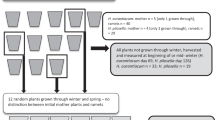Abstract
All deciduous woody tree species of the eastern United States serve as hosts for large numbers of root parasitizing cicada nymphs (Magicicada spp.)1–4. Periodical cicadas spend their larval lives 6–24 inches underground, feeding on xylem fluid from rootlets and roots5. They emerge every seventeenth year in the north or every thirteenth year in the south. Densities of cicadas underground are very great—Dybas and Davis report emergence densities of over 300 nymphs per square yard or about 1,500,000 per acre. This represents the highest reported biomass values of any naturally occurring terrestrial animal6. During the adult stage, which lasts 3–4 weeks, cicadas mate and females lay their eggs in twigs of deciduous trees. When the eggs hatch the first instar nymphs fall to the ground to begin their 17-yr development. The damaging effects to twigs by ovipositing adult cicadas is well established7–13 but the major effect of cicadas may be due to the feeding of nymphs: nymphs are implicated in a reduction in productivity of orchard trees14–16. However, no studies have compared growth of parasitized and unparasitized trees in the same environment. I report here that feeding cicada nymphs can reduce tree growth, as measured by growth rings, by as much as 30%.
This is a preview of subscription content, access via your institution
Access options
Subscribe to this journal
Receive 51 print issues and online access
$199.00 per year
only $3.90 per issue
Buy this article
- Purchase on Springer Link
- Instant access to full article PDF
Prices may be subject to local taxes which are calculated during checkout
Similar content being viewed by others
References
Butler, A. W. Bull. U.S. Dep. Agric. Div. Ent. 12, 24 (1886).
Dybas, H. S. & Lloyd, M. Ecoi Monogr. 44, 279 (1974).
Lloyd, M. & White, J. J. N. Y. Ent. Soc. 84, 148 (1976).
White, J. Am. Nat. 115, 1 (1980).
White, J. & Strehl, C. E. Ecol. Ent. 3, 323 (1978).
Dybas, H. S. & Davis, D. D. Ecology 43, 432 (1962).
Riley, C. V. Bull U.S. Dep. Agric. Div. Ent. 8 (1885).
Cory, E. N. & Knight, P. J. econ. Ent. 30, 287 (1937).
Smock, R. M. & Neubert, A. M. Apples and Apple Products (Interscience, New York, 1950).
Graham, C. & Cochran, A. B. J. econ. Ent. 47, 242 (1954).
Hunter, P. E. & Lund, H. O. J. econ. Ent. 53, 961 (1960).
Lloyd, M. & Dybas, H. S. Evolution 20, 133 (1966).
Smith, F. F. & Linderman, R. G. Env. Entom. 3, 725 (1974).
Banta, E. S. Proc. Ohio State Hort. Soc. 118, 88 (1960).
Hamilton, D. W. Proc. Indiana Acad. Sci. 71, 16 (1961).
Hamilton, D. W. & Cleveland, M. L. Proc. Indiana Acad. Sci. 73, 167 (1964).
Simon, C. M., Karban, R. & Lloyd, M. (in preparation).
Marlatt, C. L., Bull, U. S. Dep. Agric. Bur. Ent. 71, (1907).
Davis, W. T. Bull. Brooklyn Ent. Soc. 19, 182 (1924).
Marlatt, C. L. Proc. Ent. Soc. Washington 9, 16 (1908).
Forsythe, H. Y. Env. Ent. 5, 169 (1976).
Phipps, R. L. Ohio Agric. exp. Stn Res. Circ. 105 (1961).
Smith, F. F. & Linderman, R. G. Env. Ent. 3, 725 (1974).
Sokal, R. R. & Rohlf, F. J. Biometry (Freeman, San Francisco, 1969).
White, J. & Lloyd, M. Am. Midi. Nat. 94, 127 (1975).
Lloyd, M. & White, J. Evolution 30, 786 (1976).
Lloyd, M. & Dybas, H. S. Evolution 20, 133 (1966).
Beamer, R. H. Univ. Kansas Sci. Bull. 18, 155 (1928).
Author information
Authors and Affiliations
Rights and permissions
About this article
Cite this article
Karban, R. Periodical cicada nymphs impose periodical oak tree wood accumulation. Nature 287, 326–327 (1980). https://doi.org/10.1038/287326a0
Received:
Accepted:
Published:
Issue Date:
DOI: https://doi.org/10.1038/287326a0
This article is cited by
-
Foraging in the Dark – Chemically Mediated Host Plant Location by Belowground Insect Herbivores
Journal of Chemical Ecology (2012)
-
Effects of sap-feeding insect herbivores on growth and reproduction of woody plants: a meta-analysis of experimental studies
Oecologia (2010)
-
Response of host plants to periodical cicada oviposition damage
Oecologia (2008)
-
Allocating nitrogen away from a herbivore: a novel compensatory response to root herbivory
Oecologia (2007)
-
Cicadas showing up after a prime number of years
The Mathematical Intelligencer (2002)
Comments
By submitting a comment you agree to abide by our Terms and Community Guidelines. If you find something abusive or that does not comply with our terms or guidelines please flag it as inappropriate.



